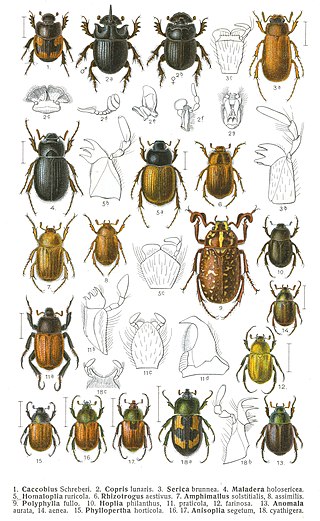
Cetonia aurata, called the rose chafer or the green rose chafer, is a beetle, 20 millimetres long, that has a metallic structurally coloured green and a distinct V-shaped scutellum. The scutellum is the small V-shaped area between the wing cases; it may show several small, irregular, white lines and marks. The underside of the beetle has a coppery colour, and its upper side is sometimes bronze, copper, violet, blue/black, or grey.

The family Scarabaeidae, as currently defined, consists of over 30,000 species of beetles worldwide; they are often called scarabs or scarab beetles. The classification of this family has undergone significant change in recent years. Several subfamilies have been elevated to family rank, and some reduced to lower ranks. The subfamilies listed in this article are in accordance with those in Bouchard (2011).

The cockchafer, colloquially called Maybug, Maybeetle, or doodlebug, is the name given to any of the European beetles of the genus Melolontha, in the family Scarabaeidae.

June beetle is the common name for several scarab beetles that appear around June in temperate parts of North America:
June bug or Junebug may refer to:

Phyllophaga is a very large genus of New World scarab beetles in the subfamily Melolonthinae. Common names for this genus and many other related genera in the subfamily Melolonthinae are May beetles, June bugs, and July beetles. They range in size from 12 to 35 mm and are blackish or reddish-brown in colour, without prominent markings, and often rather hairy ventrally. These beetles are nocturnal, coming to lights in great numbers.

Melolonthinae is a subfamily of the scarab beetles. It is a very diverse group; distributed over most of the world, it contains over 11,000 species in over 750 genera. Some authors include the scarab subfamilies Euchirinae and Pachypodinae as tribes in the Melolonthinae.

Macrodactylus subspinosus is a North American beetle of the family Scarabaeidae. The members of this genus are known as "Rose chafers", not to be confused with the European "Rose chafer", Cetonia aurata. M. subspinosus occurs from Eastern Canada to Colorado and is considered a pest of many crops and flowers. It is given its common name of rose chafer because it eats the leaves of roses, although it also feeds on many other plants.

The Cromwell chafer beetle is a species of flightless beetle in the family Scarabaeidae. It is found in just one spot in Central Otago, New Zealand, which is now a nature reserve.

Amphimallon solstitiale, also known as the summer chafer or European june beetle, is a beetle similar to the cockchafer but much smaller, approximately 20 millimetres (0.79 in) in length. They are declining in numbers now, but where found they are often seen in large numbers. At dusk they actively fly around tree tops looking for a mate and can often be found drowning in pools of water the following morning. They are also attracted to light and come in through open, lit windows and fly around lamps, making quite a racket while bumping into lights. They are found throughout the Palearctic region and, commonly seen from June to August, living in meadows, hedgerows, and gardens, and eating plants and tree foliage.

The European chafer is a beetle of the family Scarabaeidae. Formerly found only in continental Europe, this invasive species is now found at temperate latitudes in North America. The large, white grubs of A. majale feed on the roots of most cool-latitude grasses, both wild and cultivated. This has made the European chafer an enemy of lawns.
Amphimallon altaicum is a species of beetle in the Melolonthinae subfamily that can be found in Bulgaria, Greece, Romania and southern part of Russia.
Amphimallon evorense is a species of beetle in the Melolonthinae subfamily that is endemic to Portugal.
Amphimallon jeannei is a species of beetle in the Melolonthinae subfamily that is endemic to Greece.
Amphimallon krali is a species of beetle in the Melolonthinae subfamily that is endemic to Dodecanese islands.
Amphimallon nigripenne is a species of beetle in the Melolonthinae subfamily that is endemic to Turkey.
Amphimallon pygiale is a species of beetle in the Melolonthinae subfamily that can be found in France and Spain.
Amphimallon volgense is a species of beetle in the Melolonthinae subfamily that can be found in southern part of Russia and the Near East.

Melolonthini is a tribe of scarab beetles in the family Scarabaeidae. There are over 250 genera in Melolonthini, occurring worldwide; there are over 300 species in North America alone, and more than 3000 worldwide.











